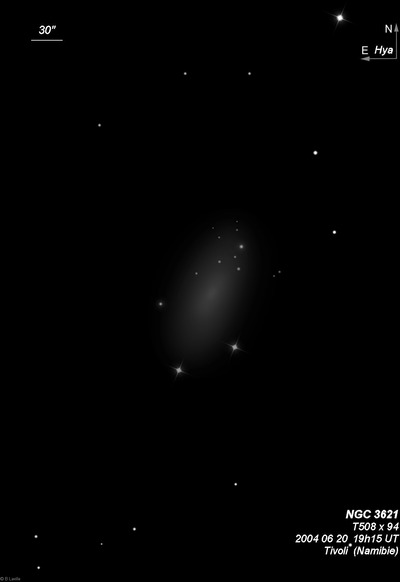
William Herschel discovered NGC 3621 = H I-241 = D 617 = h3337 on 17 Feb 1790 (sweep 808) and recorded "cB, vgbM, E from about 70° np to sf, about 6 or 7' long and near 4' broad. Within a parallelogram of stars." This is the most southerly object he discovered! From the latitude of Slough, NGC 3621 culminated at an elevation of only 6.8°!
James Dunlop observed NGC 3621 on 7 May 1826 with his 9-inch reflector from Parramatta, NSZ, and recorded "a very faint pretty large nebula, about 2' broad and 4' long, very faint at the edges. The brightest and most condensed part is near the south following extremity; a small star is involved in the north preceding extremity, and there are two small stars near the south extremity, but not involved." Dunlop made two observations and his published position is 10' NE of center.
John Herschel observed the galaxy on 29 Apr 1834 from the Cape of Good Hope and recorded, "pB, vL, oval, vgvlbM, resolvable [mottled], 5' long, 3' broad."
400/500mm - 17.5" (4/6/91): bright, large, elongated 5:2 NNW-SSE, 6' diameter, weak central concentration and along the major axis but no sharp nucleus. Several stars are nearby; three mag 11-13 stars are off the north tip and two mag 10 stars are 2.7' SW and 3.7' SSE of center.
900/1200mm - 48" (5/9/18): at 488x; this prominent galaxy is extremely large, irregular but elongated at least 2:1 NNW-SSE. The main disk extends ~7'x3' and is noticeably mottled and dappled with slightly brighter and darker areas. Around the periphery is a a very low surface brightness outer halo that dissolved into the background sky, but could be traced ~5' SE of center. The galaxy contains a very large, brighter central region, which appeared somewhat offset within the main disk, though it was less defined than a typical core or nucleus. The most noticeable features are a couple of large dust lanes that border or outline spiral arms and arcs. A long, thin dust lane extends in a SSE to NNW orientation, just east of the central region. This dark lane cuts off or borders a relatively narrow spiral arm that is adjacent to the east. It contains a brighter 10" knot (stellar association/HII complex [KWB2013] 104), that was easily visible 1.1' ESE of center and 1.1' due west of mag 12.7 star. A broader dusty lane extends SSE to NNW along the west side. A very low surface brightness arm running parallel is just west of this darker lane or gap. The galaxy is outlined by several brighter stars; two mag 10.3/10.6 stars are near the southern edge of the halo, 2.8' SSW of center and 3.9' SSE of center, and a mag 12.7 star is placed ~2.5' ESE of center. A number of stars cradle the north end of the galaxy; the brightest is a mag 11.6 star [2.6 NW of center], which forms a kite asterism outlining the galaxy, along with the previous three stars. In additional a couple of stars are superimposed on the north side of the main glow and a number of additional mag 13 and 14 stars are at the northern edge of the halo.
Notes by Steve Gottlieb